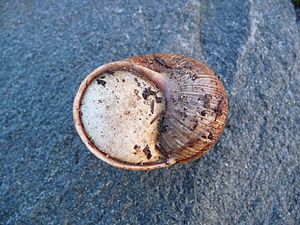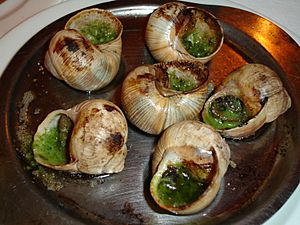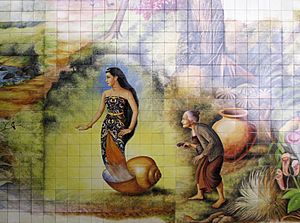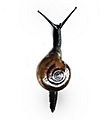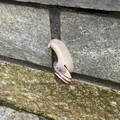Snail facts for kids
Quick facts for kids Snails |
|
|---|---|
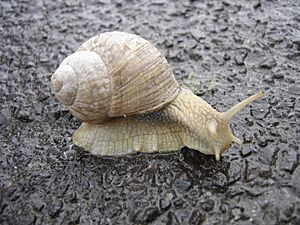 |
|
| Helix pomatia, a type of land snail | |
| Scientific classification | |
| Kingdom: | Animalia |
| Phylum: | Mollusca |
| Class: | Gastropoda |
A snail is a type of gastropod that has a shell. When we say "snail," we usually mean land snails. But the word also includes many kinds of sea snails and freshwater snails. Gastropods that don't have a shell, or only have a shell inside their body, are mostly called slugs. Some land snails have a very tiny shell they can't hide in; these are often called semi-slugs.
Snails are important to humans in many ways. They are eaten as food, can be pests in gardens, and can even carry diseases. Their shells are used for decoration and in jewelry. Snails are also known for being slow, and the phrase "snail's pace" means moving very slowly.
Contents
All About Snails
Some snails breathe with lungs, while others use gills. It's interesting that some gill-breathing snails live on land, and many lung-breathing snails live in freshwater. A few ocean snails even have lungs!
Snails live in many different places. You can find them in ditches, deserts, and even deep in the ocean. While land snails might be more familiar, most snail species live in the ocean. They are also much more diverse and numerous there. Many kinds of snails also live in fresh water.
Most snails have thousands of tiny, tooth-like structures on a ribbon-like tongue called a radula. This radula works like a file, scraping food into small pieces. Many snails are herbivores, meaning they eat plants or scrape algae from surfaces. However, some land snails and many ocean snails are omnivores (eating both plants and animals) or predatory carnivores (eating other animals).
Some snails, like the giant African land snails (from the Achatina group), can grow very big. They can be up to 15 in (38 cm) long and weigh 1 kg (2 lb). The biggest living sea snail, Syrinx aruanus, has a shell up to 90 cm (35 in) long. The whole animal can weigh up to 18 kg (40 lb). On the other hand, the smallest land snails, Angustopila dominikae, are only 0.86mm long!
The largest land snail ever recorded was an African giant snail named Gee Geronimo. It was 39.3 centimetres (15.5 in) long when stretched out and its shell was 27.3 cm (10.7 in) long. It weighed 900 grams (2 pounds).
Snails don't change much after they hatch. They hatch as tiny versions of adult snails. They just need to eat calcium to make their shells stronger. Snails can be male, female, both male and female, or reproduce without a mate (called parthenogenetic).
What Snails Eat
Snails have many different eating habits. Some eat a wide variety of foods, while others are very picky. Snails usually feed at night. They mostly eat decaying plants and other dead organic matter. Their diet can also include fungi, lichens, green leaves, worms, centipedes, insects, animal poop, dead animals, and even other slugs. Yes, some snails eat other snails!
Snails vs. Slugs
Gastropods that don't have a shell are usually called slugs. Some slugs have a small, internal shell, while others have no shell at all. Besides the shell, slugs and snails are quite similar. However, their habitats and behaviors can be different.
An animal without a shell can move more easily and squeeze into small spaces. This means even large slugs can hide in tiny spots, like under loose tree bark or under rocks and logs. These hidden spots protect them from predators and from drying out. They are also good places for slugs to lay their eggs.
The term "slug" isn't a scientific group. Slugs have evolved many times from different snail groups. This means that different types of slugs are not always closely related to each other.
Snails and Humans
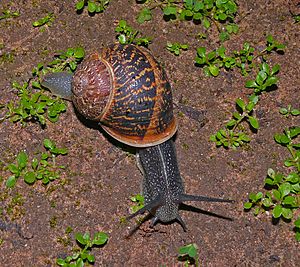
Land snails are often seen as pests in gardens and farms. But some species are eaten as a special food, and sometimes people even keep them as pets. Also, the slimy mucus from snails can be used in skin care products!
Snails in Agriculture
Gardeners and farmers use different methods to stop snails from damaging plants. They might use special sprays or less harmful options like strong garlic or wormwood solutions. Copper metal also keeps snails away, so a copper band around a tree trunk can stop them from climbing up. A layer of dry, rough material like diatomaceous earth can also deter snails.
The decollate snail (Rumina decollata) eats other garden snails. Because of this, it has sometimes been used to control pests. However, this can cause problems because the decollate snail might also eat other snails that are important to the local environment.
Snails as Food
In French cuisine, edible snails are a famous dish called Escargot à la Bourguignonne. Raising snails for food is called heliciculture. For farming, snails are kept in dark, wired cages with dry straw or wood. Before cooking, snails are often boiled and removed from their shells. Cooked snails have a slightly chewy and tender texture.
Besides being a fancy food, several types of land snails are a good source of protein for many people in poorer communities. Many land snails are valuable because they can eat farm waste, like fallen leaves in banana farms. In some countries, giant African land snails are raised for food.
Land snails, freshwater snails, and sea snails are all eaten in many countries. In some places, snails are fried. For example, in Indonesia, they are fried as satay, a dish called sate kakul. The eggs of some snail species are also eaten, similar to how caviar is eaten.
In Bulgaria, snails are traditionally cooked in an oven with rice or fried in a pan with vegetable oil and red paprika. Before cooking, they are boiled in hot water for a long time and taken out of their shells. The two most common species eaten there are Helix lucorum and Helix pomatia.
Historical Use of Snails as Food
Sometimes, in history, snails and slugs that weren't usually eaten were used as food during times of hunger. Old records from Scotland mention how different snails were used as food during times of plague.
Snails and Diseases
Snails can sometimes carry diseases that can be passed to humans. These include diseases like schistosomiasis and angiostrongyliasis.
Snails in Culture

Symbolism of Snails
Because they move so slowly, snails have often been a symbol of laziness. In Christian culture, the snail has been linked to the deadly sin of sloth. In the Psalms book of the Bible, snail slime is used as a symbol of punishment. In Mayan myths, the snail is represented by the god Uayeb.
Snails and Ancient Beliefs
Snails were often used in divination, which is trying to predict the future. The Greek poet Hesiod wrote that snails climbing plants meant it was time to harvest. The Aztec moon god Tecciztecatl wore a snail shell on his back. This symbolized rebirth, as the snail appearing and disappearing was like the moon's phases.
Love Darts and Cupid

A scientist named Professor Ronald Chase has suggested that the ancient story of Cupid's arrows might come from early observations of how land snails like Cornu aspersum use "love darts" when they mate.
Snails as Metaphors
Today, we often use the phrase "a snail's pace" to describe something that is very slow. The term "snail mail" is used to talk about regular postal service, comparing its slowness to the speed of email.
In old books from the Middle Ages and Renaissance, snails were sometimes drawn to be funny. This was because the shell of a snail looked a bit like a knight's armor.
Snails in Indonesian Mythology
Keong Emas (which means Golden Snail in Javanese and Indonesian) is a famous Javanese folklore story. It's about a princess who is magically turned into a golden snail and put inside a shell. This story is part of the popular Javanese Panji cycle, which tells tales of Prince Panji Asmoro Bangun and Princess Dewi Sekartaji.
Snails and Dyes
Some types of snails, especially from the family Muricidae, produce a special liquid that makes a color-fast natural dye. The famous ancient Tyrian purple dye was made this way, as were other purple and blue dyes. It was very expensive to get enough of this liquid, so only very rich people could afford these colors. This is why certain shades of purple and blue became linked with royalty and wealth.
Snails as Pets
Throughout history, people have kept snails as pets. There are even famous snails like Lefty (also known as Jeremy) and fictional snails like Gary from SpongeBob SquarePants and Brian the snail.
See also
 In Spanish: Caracol para niños
In Spanish: Caracol para niños
- Gastropod shell
- Pasilalinic-sympathetic compass
- Jeremy (snail)
- Land snail
- Freshwater snail
- Sea snail
Gallery


